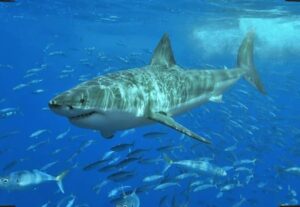Why You’ll Never See a Great White Shark in an Aquarium — The Disturbing Reality

Aquariums can be mesmerizing places—offering close-up views of sea turtles, colorful fish, and elegant jellyfish. For many, visiting one feels like entering a hidden world. But one iconic creature is always missing: the great white shark. And the reason for that absence is more tragic than most people realize.
The Truth Behind Their Absence
Despite being one of the ocean’s most feared and admired predators, great white sharks simply cannot survive in captivity. Multiple aquariums have tried to display them over the years, but every attempt has ended in heartbreak—either with the shark dying or being released early due to extreme distress.
Unlike dolphins or rays, great whites are solitary, wide-ranging animals that require vast, open water to thrive. No artificial environment has ever successfully met their physical and psychological needs.
A Long History of Failed Captivity
The first known attempt to keep a great white in an aquarium happened back in 1955 at Marineland of the Pacific in California. That shark didn’t last even a single day.
Throughout the decades, other facilities followed suit. In 1981, a young female shark was brought in under the hope that her smaller size would help her adjust. She died within a week. Even the Monterey Bay Aquarium, one of the most respected marine research centers in the world, could only keep a great white alive for 16 days—the longest on record.
These efforts weren’t taken lightly. Marine biologists closely monitored the animals, adjusted tank conditions, and made valiant attempts to replicate ocean life. Still, every trial ended with the same devastating result.

Why Great Whites Don’t Belong in Tanks
There are several crucial reasons why captivity is lethal for these creatures:
-
They never stop swimming: Great whites rely on constant forward motion to breathe. Without water flowing through their gills, they suffocate.
-
They require massive territory: No tank can replicate the hundreds of miles they naturally roam in the wild.
-
They become deeply distressed: Many captive great whites lose interest in food, crash into walls, or exhibit aggressive, erratic behavior.
Feeding them is also a challenge. These sharks hunt live prey in the wild—something that’s both impractical and ethically controversial to simulate in public spaces.
As one shark conservation organization explained, “Great whites often ram the walls of their enclosures, stop eating, and display signs of depression or panic.”
Some Wild Things Can’t Be Contained
While aquariums play a vital role in marine education and conservation, they have their limits. The great white shark is one of nature’s few creatures that simply can’t be held in a tank without suffering.
Their constant movement, need for space, and wild instincts make them impossible to confine humanely. These apex predators are built for the vast, untamed ocean—not the boundaries of glass walls and filtered water.
So the next time you marvel at the wonders in an aquarium, remember the one that isn’t there. The great white shark remains a powerful reminder that not everything in nature can—or should—be put on display.